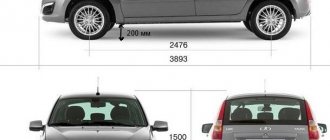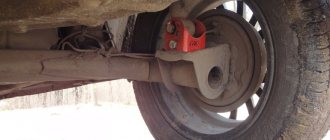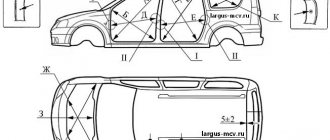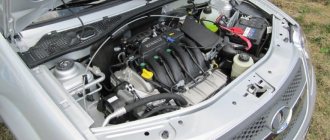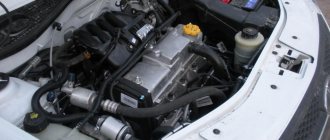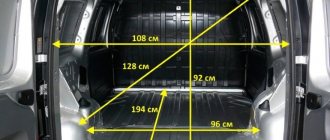Lada Largus and Lada Largus Cross
It is interesting that the ground clearance under the rear suspension beam of the Largus Cross is less than the clearance under the steel engine protection.
| Lada Largus station wagon | Lada Largus Cross | |
| Length / width / height / base | 4470 / 1750 / 1670 / 2905 mm | 4470 / 1756 / 1682 / 2905 mm |
| Track front/rear | 1469/1466 mm | 1461/1466 mm |
| Ground clearance | 170 mm | 195mm |
| Trunk volume (VDA) | 135—2350 l | |
| Curb/gross weight | 1370/1850 kg | |
| Acceleration time 0–100 km/h | 13.5 s | |
| Maximum speed | 165 km/h | |
| Fuel/fuel reserve | AI-95 l | |
| Fuel consumption: urban/suburban/combined cycle | 10.1 /6.7 /7.9 l/100 km | 11.5 /7.5 /9.0 l/100 km |
| ENGINE | ||
| Type | petrol | |
| Location | front, transverse | |
| Configuration / number of valves | P4/16 | |
| Working volume | 1598 cm³ | |
| Power | 75/102kW/hp at 5750 rpm | |
| Torque | 145Nm at 3750 rpm | |
| TRANSMISSION | ||
| type of drive | front | |
| Transmission | M5 | |
| CHASSIS | ||
| Suspension: front/rear | McPherson/elastic beam | |
| Steering | rack and pinion, with hydraulic booster | |
| Brakes: front/rear | disc/drum | |
| Tires | 185/65 R15 | 205/55R16 |
Other reviews
Against the background of the constant appearance of new cars on the world market, the Lada Vesta of the 2015 model year is not such a new product. However, it can still be considered the discovery of the Russian car market thanks to its very modern appearance and well-thought-out technical “stuffing”. The sedan's exterior was designed by ex-Mercedes-Benz and Volvo designer Steve Mattin, and was among the first people lucky enough to sit in it.
The raised cross-country hatchback Lada Xray, which AvtoVAZ dubbed a crossover for advertising purposes, is called by many the highest quality model of the domestic manufacturer, and there is indeed reason for this. Firstly, there is an abundance of high quality imported parts, and secondly, this car has decent ground clearance and a proprietary 1.8-liter engine.
Cars nowadays don't work on anything. There are even hydrogen ones that literally “live” on fuel cells. Water is, of course, good and incredibly environmentally friendly, but it is still painfully unpopular and expensive to implement. Is it compressed natural gas or, as it is also called, methane in a cylinder, like the new version of Lada Vesta CNG (Compressed Natural Gas)! A gas sedan is cheaper.
5- and 7-seater Lada Largus station wagons appeared on the Russian market in 2012, becoming a kind of continuation of the cheapest Renault Logan model, only under the auspices of a domestic manufacturer. As you might guess, the Logan-like Largus turned out to be the first Lada car built on the basis of the budget B0 platform, on the basis of which a number of Lada, Renault and Nissan models were designed.
The domestic auto industry never ceases to amaze. For example: when the Russian press first said that AvtoVAZ was preparing a “sports” version of the second Lada Kalina in a hatchback body, it was more difficult to get a new product for a test drive than another Bentley or Mercedes. Amazing, right? For VAZ people there is nothing special about this: not many significant new products are released after all.
What is a 3- or 5-door Lada 4×4 with the Urban prefix? Some kind of supernova Niva? In relation to an off-road passenger car from the glorious city of Togliatti, these words smack of piercing irony. New, of course - it’s been around for almost 40 years, of which 10 years the model has not been called Niva. But somehow I can’t seem to forget about my “maiden name”... So, what does “urban” promise?
It will not be a revelation to anyone that AvtoVAZ literally slept through the SUV boom. And one day they decided to somehow make up for this matter and in the summer of 2014 they presented to the general public the all-terrain all-terrain station wagon Lada Kalina Cross, built on the basis of Kalina 2. In order to become a “Cross”, the model had to survive not only external, but also internal, technical.
Control dimensions of Lada Largus body geometry / Lada Largus
How to increase ground clearance using spacers
Dimensions of openings and clearances of mating body parts LARGUS
| A | B | IN | G | D | E | AND | 3 |
| 1380 ± 5 | 930 ± 4 | 1280 ± 5 | 1155 ± 15 | 925 ± 5 | 975 ± 5 | 1110 ± 5 | 610 ± 3 |
| AND | TO | L | M | N | ABOUT | P | |
| 795 ± 3 | 735 ± 3 | 1530 ± 5 | 800 ± 5 | 1380 ± 4 | 1030 ± 3 | 1140 ± 3 |
Mounting points for suspensions on the body
1 – front subframe mounting points; 2 – shock absorber strut attachment points; 3 – rear subframe mounting points; 4 – guide holes of the front spar; 5 – front guides of the rear spar; 6 – guide holes for mounting the rear suspension; 7 – rear suspension mounting holes; 8 - holes for mounting the rear shock absorber; 9 – rear guide holes of the rear spar.
Scheme for measuring interaxial dimensions
Comparison of versions
Ground clearance (ground clearance) Renault Logan
The car has only three trim levels: Standard, Norma, Luxe. But these trim levels, with the exception of the very first, come in addition to three packages: Climat, Comfort, Prestige. The simplest Standard package is equipped with safety systems: ABS and EBD, these systems are supported by a driver airbag, Isofix child seat mounts, and the Era-Glonass emergency warning system (more recently, this system is required for installation on all cars that drive on the territory of the Russian Federation), child locks of the rear doors (allow you to block the interior door handles when the outside ones are active).
Among the functions that increase comfort and ease of control, there is a steering wheel height adjustment, a 12-volt power socket, a cabin air filter, audio preparation, roof rails and a full-fledged spare wheel. There is no add-on package available for this configuration. The second version on the list is Norma, which adds to the list of equipment, including power steering, a 60:40 folding rear seat, central locking, and front electric windows. The appearance is complemented by moldings around the perimeter of the body and bumpers in body color. There are also two option packages to choose from. The first is a simpler Climat package, it includes heated front seats and air conditioning, the second is a slightly richer Comfort package, it adds a shelf in the ceiling above the luggage compartment, and a floor covering the trunk, an audio system with two speakers (supports Bluetooth protocol, and also has USB and AUX ports).
Photos of the interior of Lada Largus 2021 (2017)
The most expensive Luxe package is equipped with a front passenger airbag, also has: an on-board computer, central locking with remote control, rear electric windows, electrically adjustable and heated rear-view mirrors, rear parking sensors, and a driver's seat with lumbar and height adjustment, the audio system receives two additional dynamics. But even the most expensive trim level has its own Prestige package of additional equipment; this package provides: leather steering wheel trim and alloy wheels with a diameter of 15 inches. The Largus Cross version is equipped with only one trim level: Luxe and no optional packages are available to it. But it has access to alloy wheels of a larger diameter and different tires, due to which it becomes even taller.
Interior
The new station wagon has been updated with little, not only on the outside, but also on the inside. First of all, the interior of the car has been transformed in terms of design, but the functionality and service elements have remained largely untouched. The most noticeable thing here was the introduction of orange elements into the interior of the doors, front panel and seats, by the way, made of high-quality leather.
The upholstery of all seats is clearly highlighted with orange stitching. On the thresholds you can see the inscription “Largus Cross” appearing. The steering wheel, unfortunately, has undergone certain changes, causing mixed feelings about the ease of use. In addition, the sound signal remained under the steering wheel.
The presence of buttons and switches is reduced to the required minimum. Those that are available remain in the same places as in the basic version of Largus. The steering wheel does not have multifunction, behind it there are information sensors: speedometer, chronometer and reminder indicators.
On the right is a modern radio built in the middle with standard functions: CD, USB, AUX, Bluetooth and radio. Below this are service keys and a control unit for the stove and air conditioner, which are already present in the database. The high gear lever and parking brake lever are installed even closer to the driver's hand.
The “station wagon” is provided with a full power package, although driving it causes inconvenience. Surprisingly, transmission control was not added, because in the station wagon only the front axle remained driven.
Of course, this arrangement of options controls takes some getting used to. But, despite the various nuances, sitting in the cabin of the Lada Largus Cross you feel very comfortable, and this applies not only to the front row, but also to the second, and if there is one, then passengers in the third row will not feel confined. Moreover, you can notice that even the basic version already has an Airbag that protects the people sitting in front.
Such arrangements can be disappointing. After all, in fact, VAZ introduced only fairly minor changes. But you shouldn’t write off this model just for this reason. The list of shortcomings in ergonomics is not so long, but was largely inherited from platform models.
Looking at the photo of the Lada Largus interior, you understand that perfection is still far away, however, the interior does not look so wooden. The level of comfort is ensured by the front profiled seats, which have received noticeable lateral support and a heating function. The driver's seat itself can be adjusted in height and lumbar support.
Three tall passengers can easily sit on the rear sofa, and they will not feel discomfort in the head or legs. There is enough free usable space. In the seven-seater version of the Lada Largus Cross 7, in the aft there is another sofa with a couple of seats.
In the stern there is another sofa with a couple of seats
You can sit in the “gallery” without any particular difficulties, and there will be enough space, so there will be no embarrassment. The developers did a good job on the functionality of the interior, so they managed to equip the interior with various unique elements. The shoulder area now features attractive orange leather inserts. Largus Cross 2021, a new model, will undoubtedly be able to please motorists with its thoughtful functionality.
Ground clearance (ground clearance) of Lada Largus Cross: real indicators
Lada Largus 1.6 mt luxe 7 seats (06.2015 - 02.2016) - technical specifications
Lada Largus Cross was created by a domestic manufacturer with the goal of giving an ordinary station wagon a similarity to an SUV.
Significant innovations in Lada Largus
In order to understand the scale of the changes that have occurred in the car, we need to draw a parallel between the cross and other equally powerful engines that are identical in configuration to the Largus. So:
- appearance: in Largus cross it has not changed much, but it is slightly taller than the donor. You can see unpainted bumpers with gray inserts on the bottom and black wheel arches and sills. The wheel diameter has increased from 15 to 16 inches. The Cross acquired “prestige” status due to alloy wheels instead of stamped ones. The interior has also not changed, only the upholstery. The crossover has intersecting lines, and there are also gray plastic inserts on the doors. There is another option for interior colors - with bright orange inserts instead of gray ones;
- The Lada Largus Cross is 35 kg heavier than usual, the shock absorber rods and the springs themselves are longer. The plastic body kit adds brutality and protects the car’s paintwork from damage when driving over rough terrain;
- cross economy: the cross spends 1.4 liters more per kilometer in the city than a regular station wagon.
What is the advantage of the Lada Largus Cross
- The car is well equipped: there are electric mirrors and adjustments, heated seats, fog lights, good standard acoustics, power steering, air conditioning, standard metal engine protection, and much more. Sitting in the Lada Largus Cross, you will feel no worse than in any other foreign car. All this is due to the high functionality and equipment of the machine.
- The appearance is decent, much more interesting compared to other models. You can be pleased with alloy wheels with a radius of R16.
- The car has excellent power: with a weight of 350 kg and with two passengers, you will not feel any discomfort.
- Quite an energy-intensive suspension.
- Lada Largus Cross has a 16-valve 1.6 liter engine.
- The car itself is very roomy.
- The most important advantage of the Lada Largus Cross is its high ground clearance! Many car enthusiasts appreciated this: you won’t feel the holes, bumps and all the other delights of Russian roads; the bottom doesn’t touch the ground at all. The ground clearance is only 170 mm, but drivers say it feels like 200 mm.
What is clearance
Ground clearance is ground clearance, the distance from the bottom point of the body to the ground. The lower the clearance, the more stable the car is on the road, but high ground clearance also has advantages. For example, high cross-country ability of a car.
How to calculate the lowest ground clearance reference point? It's simple, you need to count from the crankcase protection to the ground. There are simply no details below.
The calling card of the Lada Largus Cross is its ground clearance. Since 2015, the car's ground clearance has been increased by as much as 25 mm! The domestic manufacturer replaced the springs, shock absorbers and other suspension elements, which increased the ground clearance by 15-20 mm, and also changed the wheel diameter from R15 to R16, so that the Largus Cross became as high as possible. An experiment with wheels added 5 mm to the car.
As we know, on the previous Lada Largus model, at full load, the ground clearance is 145 mm, and with curb weight - 175 mm.
But how much ground clearance is there on the Lada Largus with the cross prefix? The characteristics of the car indicate that when fully loaded the ground clearance is 170 mm, and without load it is more than 180, namely 210 mm! Moreover, it is the same for both a 5-seater and a seven-seater station wagon! This car is called a car for tourists.
But we need to be sure of this one hundred percent, so let’s inspect the bottom of this off-road version. We can immediately notice that the muffler is hidden in the tunnel, but if we compare it with the Kalina Cross, it is not so deep. We also see that they used more reliable and durable engine protection. So, we measure the clearance, and as a result we get 195 mm!
Reviews about the Lada Largus are as follows - it is the best car, it is comfortable and drives very smoothly both on the highway and off-road. You won't notice the difference! Have a nice ride!
Design
Ground clearance (clearance) of the Lada Largus in various bodies: van, 5 seats
Lada Largus Cross 2018-2019 is a new domestically produced model. Although Lada cars evoke conflicting feelings among many, these cars are still worthy of attention, if only because of their budget and accessibility.
The design of the car cannot be called original and too attractive. This is explained by the fact that the manufacturer tried not to increase the cost of the model with unnecessary elements. Therefore, everything here is restrained, and every detail has a clear purpose.
Exterior
Although manufacturers worked for a long time to create the design of the model, the new Lada Largus Cross did not become particularly attractive in terms of design. The main distinctive features of the model are:
- rear view headlights are located on stands, have an original shape, but without additional diodes;
- both bumpers are made of plastic. There is an air intake on the lower part of the front;
- There is a plastic protection along the entire perimeter of the body that protects the car from additional injuries from stones flying off while driving;
- The radiator grille has a discreet rectangular shape. The brand icon is located in the center;
- rectangular side windows. The body resembles a raised station wagon;
- The rear doors are two swinging doors. But the negative point is the lack of a cover for the spare wheel.
To understand in detail what is mentioned above, it is best to simply look at the photo of Largus Cross. The picture demonstrates that the main motto of the manufacturer was simplicity. Even a car that can accommodate seven does not give the impression of an impressive SUV (although the dimensions are considerable).
This has logical reasons, because the domestic auto industry is trying to create models that will be accessible to average citizens. Therefore, it is necessary to reduce the price of the model range. This is not to say that the car is bad overall - for those looking for a budget option, it is almost ideal.
Interior
The photo of the Lada Largus Cross shows that the interior is also relatively modestly decorated. Although the manufacturer tried to update the interior, again, in order to reduce the final cost, he preferred to use budget materials. However, there is no need to think that this had a negative impact on quality. The entire latest sensor system is present here - there is simply no unnecessary stuff.
The interior trim is made using fabric and plastic. By the way, in all variations the interior is decorated with materials of several colors, which are combined with each other, creating a seamless range.
The steering wheel has 3 spokes, but there are no control buttons on them. The instrument panel includes 2 round indicators and a small analogue panel between them.
The center console contains a radio and control buttons. The cabin has a stove and air conditioning. There is no impressive tunnel between the front seats.
The third row of seats is represented by 2 separate chairs. But the second row is a combination of a sofa for 2 passengers and one separate chair (which reclines to provide access to the third row). In the 5-seater version it is simply a one-piece sofa for 3 passengers. There are no dividing armrests.
Specifications
Power unit
The cargo-passenger version of the Lada Largus has two naturally aspirated four-cylinder gasoline engines. The “standard” role is played by the 1.6-liter VAZ-11189 power plant, which received a distributed injection system and an eight-valve gas distribution mechanism. All this allows the Lada Largus to produce 87 horsepower and 140 Nm.
More expensive configurations already have a 1.6-liter VAZ-21129 engine, which received multi-point power and a sixteen-valve timing mechanism. The 16-valve Largus already produces 106 “horses” and 148 Nm. It takes 13.5 seconds to reach the first hundred, and the “maximum speed” is 165 kilometers per hour. In combined mode, the power unit requires about 7.9 liters of fuel per 100 km.
Although this station wagon was not updated externally after its release, it was always improved technically. For example, in December 2015, the car was equipped with an 87-horsepower power unit instead of the “French” Renault K7M with 84 horsepower. After August 2021, instead of the 102-horsepower Renault K4M, they began to install a Russian power plant designed for 106 horsepower (the engine was produced by the VAZ plant).
Transmission
All engines work only with a 5-speed manual gearbox. All torque is transmitted only to the front wheels.
Chassis
This vehicle is based on the front-wheel drive platform B0 of the Renault-Nissan association. There are standard McPherson struts up front and a semi-independent U-beam at the rear. The steering device has a rack-and-pinion design and is complemented by a hydraulic power steering wheel (the basic configuration does not have a hydraulic power steering).
The braking system is equipped with ventilated disc devices at the front and drum mechanisms at the rear. The electronic ABS system is not supplied only for the standard version; all other configurations already have it by default.
Safety
The Lada Largus 2021 station wagon is a modern car, so experts have not ignored the practical model in terms of safety. There is a latest generation anti-lock braking system. The power frame of the body was designed to minimize bodily injury to passengers in a collision.
All seats have three-point seat belts and head restraints. The driver and front passenger have front and side airbags. Lada Largus 2021 fully complies with current European requirements for passive safety. This is availability:
- Driver and passenger airbags;
- Front seat belts with force limiters;
- The front subframe acts as an additional side member, absorbing and redistributing the energy of a frontal impact;
- Three-point seat belts and head restraints;
- Anti-lock braking system;
- ISOFIX child seat mounting systems;
- Indication of unfastened driver's seat belt;
- Honeycomb inserts in front door panels;
- ERA-GLONASS systems.
Asceticism
The only obvious drawback of the Lada-Largus is its deliberate asceticism. The interior of the car has not changed at all since the creation of the first generation Renault Logan. This model contains only the bare minimum. But many car enthusiasts today want to see some additional frills in their cars, such as heated seats and mirrors, modern multimedia, and electronic assistants. The impressive dimensions of the Lada-Largus van, heated front seats, a single-din radio, an ABS system and rear parking sensors are all that are included as standard. The car is equipped with only two airbags and manual air conditioning.
Many cars are created with the aim of setting speed records and most of them captivate with their stylish and original design. The Lada-Largus van, with a body size that allows it to transport large items, was invented specifically for work and family. The car will be able to drive where sports cars with low clearance cannot move. At the same time, drivers will look at the Lada-Largus with real love, because only a working car is considered truly beautiful.
What is the carrying capacity of the Lada-Largus: comparison with competitors
The certified carrying capacity of all modifications of the Lada Largus, calculated as the difference between the curb and gross weights of the vehicle, has the following values:
- 445 kg for a 5-seater station wagon;
- 480 kg for the 7-seater version and for Largus Cross;
- 750 kg for a van.
Undoubtedly, the characteristics are impressive for a B-class family car, and the Largus van is comparable to the capabilities of representatives of the commercial LCV segment, such as the GAZ-2752 Sobol.
However, considering cargo capabilities only in terms of payload is not entirely correct. After all, humanity invented trucks to transport cinder blocks and floor slabs. And for a typical station wagon owner, the most important thing is to answer the question of whether he can carry ten packs of insulation at a time, and whether a two-meter refrigerator will fit into the cabin.
Therefore, it is possible to more objectively assess the cargo capabilities of the Lada Largus based on the volume of the luggage compartment and its dimensions (depth, width and height).
In addition, we should not forget about the price component: the Audi allroad station wagon with a three-liter engine has a comparable maximum load capacity of 500 kg, but the cost is equal to 8.5 Largus.
Video about choosing between Kalina station wagon and Largus
Not quite a "cross"
As for its “elder brother” and another representative of the VAZ cross-line, Largus Cross, we did not include it in the table - only one official figure is known for this car: ground clearance of 175 mm when fully loaded. This is also a good value, and if only this is taken into account, then Largus Cross could be considered a crossover. But you and I understand that not everything is so simple: this car has a large wheelbase and long overhangs, so it cannot lay claim to high numbers in terms of approach, departure and ramp angles.
Therefore, both Largus Cross and Kalina Cross are all-terrain station wagons, even without the hypothetical possibility of versions with all-wheel drive. Note that all other participants in our comparison have all-wheel drive. It is precisely because of the latter circumstance that the cross-country “Largus” and “Kalina” are “SUVs” like the Renault Sandero Stepway and other Geely MK Cross.
Only the Lada 4×4 Urban, conceived as a “light version” of the Lada 4×4 SUV, could be considered a real crossover in the VAZ cross-line. This is a modification that has all-wheel drive and is geometrically almost identical to the classic Niva, and even surpasses it in approach and departure angles - due to the bumpers protruding less beyond the dimensions of the body. But in the form in which it began to be produced, it is not even a crossover, but an SUV, essentially the good old Niva, which received a small upgrade.
Because the introduction of a transmission without lowering, electronic differential locks, new wheels and lowered ground clearance has been postponed until 2015 at best. In a word, AVTOVAZ does not yet have a single real crossover: the Lada 4×4 has not turned into a crossover, and the Largus and Kalina remain station wagons.
"Thanks, Cap! Calm down already, everyone understands perfectly well that Kalina Cross is a raised “barn” and not a crossover at all.” If the author were not an author, but a reader, he would also want to leave just such a comment under the material. But don't rush, friends.
All of the above is only to remind you once again: don’t be fooled, think with your head. After all, marketers often want to sell a product so much that they, without hesitation, deliberately blur the terminology and replace concepts. Here is a photograph from the author’s personal archive, taken at Kurumoch airport in August 2014.
Equipment
In all respects, with the exception of ground clearance, the cars are absolutely identical. This model, regardless of what brand it is produced under, was designed on the B0 platform. Dimensions are equal to L-W-H: 4470-1750-1670 mm. The ground clearance varies for the regular version: 175 mm when unloaded, 150 mm when loaded; for the Cross version the ground clearance is 195 mm. The trunk volume is also very variable, from 135 liters in the seven-seater version with the seats folded down. Then 560 in a five-seater, and 2350 liters, although only with two seats. The fuel tank volume for gasoline versions is 50 liters and the gas tank volume is 90 liters for CNG versions.
The range of engines is represented by both Renault and AvtoVAZ engines. The weakest in the range is the French-developed inline four, factory code K7M. The volume of this engine, like other Largus engines, is 1.6 liters. Power is around 82 horsepower at 5500 rpm and torque of about 124 Newton meters. Fuel consumption in the combined cycle is 9.3 liters, in the city 12.3, on the highway 7.5.
The second most powerful engine is a Russian one with the same volume and number of cylinders. The VAZ engine code is 11189, essentially the same K7M, only with slightly different attachments and modified engine mounts. Its power has increased to 87 horsepower, and torque to 140 Newton meters.
The third engine is the 1.6 installed on Megan and Logan with sixteen valves and a power of 102 horsepower at 5750 rpm and 148 Newton meters at 3750 rpm. The code for this motor is K4M. Fuel consumption: about 9 liters in the city and 7 on the highway.
The fourth power plant is the VAZ-21129, essentially the same engine as was installed on the Priora, only it complies with Euro-6 emission standards. Power is 106 horsepower at 5800 rpm, torque is 148 Nm at 4200 rpm. The consumption of such an engine in the city is about 11 liters, on the highway 6.4. In the combined cycle, consumption fluctuates between 7-8 liters per hundred. The chassis is presented with an independent McPherson-type suspension with anti-roll bar at the front. At the rear there is a U-shaped beam with programmable deformation zones. The brakes are disc at the front, drum at the rear. Steering mechanism, rack and pinion, at extra cost or in more expensive trim levels with power steering.
The reference point for ride height is the crankcase protection
The question is what exactly is considered the lowest point. For all passenger cars, for example, everything located near the hubs is excluded from consideration. Otherwise, we would have to count the ground clearance from the ball joint housings. You understand what value the result would have.
Under the bottom of Largus with a 16-valve internal combustion engine
The picture above shows what the bottom of a Largus car (van or station wagon) looks like. The engine here is protected by a metal insert. From it, that is, from the crankcase protection, the clearance is measured. The parts located below cannot be found on the bottom.
Van ground clearance
Van ground clearance is 145 mm
And the value was measured this way: the car was fully loaded. There were 4 passengers and a driver in the cabin, and the trunk also did not go unnoticed. The 7-seater version added two more passengers. In general, everything was fair.
Fully loaded and standard curb weight – where did “155 mm” come from?
Studying the specifications of the Dacia Logan station wagon, you might be surprised: the ground clearance indicated in the documents is 155 mm! By the way, Logan MCV and Largus are the same model.
Dacia Logan MCV (station wagon)
The question remains which numbers should be trusted. And the answer is simple:
- AvtoVAZ carried out measurements at full load;
- Renault uses a different method - the body must be loaded to the “standard curb weight”.
Curb weight is the weight of the vehicle, as well as consumables and the driver. There is a small nuance here: if the documents indicate the tank volume as “40 liters”, but in reality it is 50, then they will fill it with exactly 40 liters of fuel. This technique is used by the Renault concern.
Clarification for cross-version
The VAZ plant managed to make crossovers from ordinary Logan station wagons. The front suspension was modified, and the springs at the rear also had to be replaced. The tire size also changed: it was 185/65 R15, now it is 205/55 R16. As a result of all the changes, ground clearance has increased by 25 mm.
Here the clearance exceeds 180 mm
So, the value of ground clearance for the Largus Cross station wagon:
- Fully loaded – 170 mm;
- Without loading – more than 180 mm.
Let us remind you that the value is measured as the distance from the ground to the crankcase protection.
The typical value for the Duster crossover is “200 mm”, but it was measured using Renault’s method – a full load was not used. Largus Cross, therefore, “lags behind” Duster by only 20 mm or less.
Van ground clearance
Note that the ground clearance of the cargo version of the Lada Largus, referred to as a “van,” is equal to a similar numerical value of 145 mm. The measurements were made according to the following principle. The car was fully loaded. Four passengers were placed in the cabin along with the driver. In the 7-seat option, the company was expanded with two more passengers. The luggage section also did not receive enough attention. In general, all the testers were “burning” with the desire to make the experiment as fair as possible.
Fully loaded or at standard curb weight? Where did “155 mm” come from?
Having gone into a careful study of the regulatory specifications belonging to the universal modification of the Dacia Logan, one can fall into boundless amazement, because it includes a clearance value of 155 mm. Note that the Logan MCV paired with the Lada Largus Cross are completely identical models.
Now each of us is faced with the question: what information can we trust? The answer is painfully simple:
- experimenters from AvtoVAZ conducted a test with a full load;
- Renault takes a different approach by loading the vehicle only to its standard curb weight during the test.
The manufacturer means the curb weight of the car, plus the driver and consumables. Here the situation has a slight nuance: the tank volume actually holds 50 liters of fuel, but the documentation shows a parameter of 40 liters. The French from Renault will fill exactly 40 liters for the test.
Unfasten the partition or part of it
The partition separating the body and the cabin consists of two halves. They can be removed separately. Both parts are screwed to the body with screws designed for a 13mm key size. Of course, you need a socket wrench.
Screws 1 were hidden under the casing
The four screws on the left and right are located on the cab side. And to unscrew them, remove the casing.
All actions with cladding
The left part of the septum is removed after the right. To remove only the left half, first remove both, and then mount the right sash back. Based on this, immediately decide where you will remove the trim - only on the right or on both sides.
So, let's start dismantling the trim: you need to remove the seat belt (key “17”), and then unscrew one self-tapping screw. A Torx T20 wrench is suitable for the self-tapping screw.
Two parts “1” prevent the removal of casing “2”
It is necessary to unscrew all the parts numbered 1. And the casing will have to be removed, overcoming the resistance of the clamps.
Linear dimensions of the cargo compartment of the Lada Largus van
All the sizes you need to know are shown in the photo. The van doors here are fixed at an angle of 90 degrees, but they can be opened all the way to 180. They are fixed in either of the two positions.
Luggage compartment of a Largus van
Let's list everything that is marked in the figure:
- The greatest height of the opening is 92 cm;
- Opening width – 108 cm;
- The distance “from arch to arch” is 96 cm;
- The distance from the edge of the threshold to the partition is 194 cm.
If you lay sheets diagonally, the width of the sheet should be less than 130 cm.
In fact, the maximum lifting capacity exceeds a ton. It all depends on the road conditions and driving style.
Interior of Lada Largus according to owner reviews
Reviews of the owners of the model about it will help to perfectly summarize the review of the Lada Largus interior. Having summarized all the responses, we can confidently state that the car’s interior satisfies the desires and needs of all its owners. Of course, it is not without some shortcomings, but it still has more positive features. Regarding the latter, the owners highlight the following advantages of the Largus salon:
- spaciousness;
- convenient location of almost all pockets, cup holders, etc.;
- comfortable organization of seats;
- interior functionality;
- absence of unnecessary elements.
Despite such a positive characteristic, the owners of the model often highlighted some shortcomings of its internal design. The general list of these is as follows:
- not very comfortable rear door handles;
- inconvenient location of some buttons (for example, the horn button);
- inconvenient location of the window lifter keys.
With the exception of these shortcomings in the interior of the Lada Largus, its characteristics are positive both in terms of functionality and in terms of design solutions.
In general, the interior of the model is very similar to its prototype - Renault Logan, which has been noted more than once by experienced car enthusiasts and car experts. The main difference between the interiors of the two cars is that the Lada Largus was adapted for the Russian car market. There’s definitely nothing bad to say about the interior of the model. In general terms, it represents a fairly well-designed and high-quality interior of a small class car. We hope the material presented above was useful to you. Good luck on the roads!
Video review of Lada Largus:
- Technical characteristics of LADA Largus
- Largus Cross: test drive and video
- Largus crash test
- Video test drive Lada Largus
Modification of the rear wiper
Actual fuel consumption per 100 km for the Lada Largus. Lada Largus technical characteristics fuel consumption
Unfortunately, the rear wiper operating mode on the Lada Largus does not have an intermittent mode - when turned on, it works constantly.
To switch the wiper to work with a variable pause, use:
- wiper relay marked 723.3777;
- standard 4 or 5-pin connector for automotive relay;
- round terminals;
- terminals 3 mm wide (“male + female”);
- pieces of wire;
- heat shrink tubing for insulating connections.
To connect an additional relay, ground wires are used that have black markings on the steering column switch block (third from the right on the side of the wires), as well as turning on the rear wiper (white, second from the right) and turning on the rear washer (gray, far right).
The rear wiper of Lada Largus can be modified by installing an additional relay
An additional relay is installed in the gap between the block and the wire route. At the same time, in order for the electrical circuit to be returned to its original state without any problems, standard connectors and terminals are used to connect an additional relay.
The principle of the modification is that when the rear wiper is turned on, the voltage previously supplied to it directly is now supplied to an additional relay, which, after modernization, controls the operation of the wiper, providing the necessary pause between strokes.
An additional advantage of using this relay is that when the rear washer is turned on, the wiper automatically switches to continuous operation mode, and after 3-4 cycles it again switches to pause mode.
The entire structure is mounted next to the steering column switch and secured with plastic clamps.
Specifications
| Characteristic | 1.6MT |
| Engine's type: | Petrol |
| Engine capacity: | 1598 |
| Power: | 106 hp |
| Acceleration to 100 km/h: | 13.1 s |
| Maximum speed: | 165 km/h |
| Consumption in the urban cycle: | 11.5/100km |
| Extra-urban consumption: | 9.5/100km |
| Combined cycle consumption: | 9.0/100km |
| Fuel tank capacity: | 50 l |
| Length: | 4470 mm |
| Width: | 1756 mm |
| Height: | 1682 mm |
| Wheelbase: | 2905 mm |
| Clearance: | 170 mm |
| Weight: | 1270 kg |
| Trunk volume: | 560 l |
| Transmission: | Mechanical |
| Drive unit: | Front |
| Front suspension: | Independent – McPherson |
| Rear suspension: | Semi-independent – torsion beam |
| Front brakes: | Disk |
| Rear brakes: | Drums |
| Production: | Tolyatti |
The difference between the Lada Largus Cross and the regular Largus
There are few differences in appearance between the “brothers”. If you look closely, you can conclude that the “off-road” version is slightly higher than the basic version. It has unpainted bumpers with gray inserts on the lower part and additional black trim on the wheel arches and sills.
If the standard version of the Lada Largus has 15-inch wheels, then the Cross version has 16-inch wheels. Although they have a similar “spare wheel”, designed for 15 inches, but if the first option has a full-size spare wheel, then the 2nd version only has a “replaceable” one. The crossover version has alloy wheels already in the base, but for the regular Largus, a similar option comes only in the Luxe Prestige package.
Speaking of the interiors, it is worth saying that they are quite similar, but the upholstery of the “crossover” seats was enlivened with the help of intersecting stitches. The model has gray plastic inserts, similar ones were installed on the doors. It would not be superfluous to add that you can decorate the interior with similar bright orange inserts. The interesting thing is that all this does not require any additional payments.
Based on the measurements, it became clear that the ground clearance of the Largus Cross model was as much as 210 millimeters. For a vehicle that was intended to be used regularly on asphalt, this is a pretty good option. For a regular Largus Cross, the ground clearance does not exceed 182 millimeters.
It is also interesting that the Lada Largus Cross weighs 35 kilograms more than a regular car. However, one body kit made of plastic, which gives a brutal look and protects the car’s paintwork from scratches while driving on a bad road, cannot weigh that much. Some percentage of the 35 kilograms can be attributed to the larger wheels.
If you drive both vehicles onto lifts, remove the wheels and conduct a careful inspection, you can still find the differences. Largus with the name Cross, has original A-pillars. For example, the designers welded the spring cup to the body 30 millimeters higher than on the station wagon. Partly with the help of this, it was possible to achieve increased clearance.
It is also important that Monroe struts were installed on both models. The rear wheels have different gas-filled shock absorbers
This can also be seen by the identification numbers. The body and shock absorber rod of the Lada Largus Cross are longer, and the rear suspension springs have been increased in length.
Based on the words of VAZ employees, while working on the suspension of the Cross model, they were given the goal of preserving the suspension settings of a standard vehicle as much as possible. It is worth saying that they coped with it. Speaking about handling and the level of comfort when moving, the cars are very similar.
Simply put, an ordinary driver most likely will not feel the difference in driving a car on a good road surface. But if you drive onto a dirt road or broken asphalt, the Cross looks a little better in terms of ride smoothness. This was achieved thanks to the increased rolling radius of the wheels and wider tires.
Many drivers prefer cars that do not consume much fuel. The Cross version consumes 1.4 liters more for every 100 km than a standard station wagon in city mode and 0.8 liters more when traveling outside the city. In the city the difference is noticeable. Since the gearbox transmission data has not changed, I would like to hope that the issue is aerodynamics, wheel size and additional weight - 35 kilograms.
If we summarize all the information said, then the machines do not differ much from each other. When you want to get a better ride and level of comfort, or you often need to drive through fields and small bushes without causing damage to the body, then the Largus Cross option is suitable.
When every dollar counts, a simple version is suitable, which costs much less and is more economical
It is also important that the Lada Largus station wagon has an eight-valve power unit under its hood, which even accepts 92-octane gasoline. But a sixteen-valve power plant can only consume 95 grade gasoline
Paying attention to sales statistics, of the 26,460 Largus models that were sold in 11 months of 2021, half were just the simple version. About 30 percent of drivers chose the Cross version, while the remaining 20 percent preferred the van
Automatic door locking when a certain speed is reached
It is worth noting that this function is available in many additionally installed alarms, however, Lada Largus owners can activate it themselves, using only the standard car system.
To activate the automatic door locking function, minimal intervention in the standard wiring of the car is required, as well as the presence of a special adapter for connecting the UCH (central electronic switching unit in the cabin) to the computer and special software.
Automatic door locking while driving is very convenient
So, at the first stage, you need to send a signal from the speed sensor to the UCH. To do this, connect a wire from pin 22 of the left connector of the instrument cluster to pin 6 of the brown insert on the black UCH connector. Using this wire, when a +12V control signal is applied to it, when the speed determined in the next step is reached, the doors will be locked.
Now it is necessary to determine the speed threshold, upon reaching which the locking will occur.
To do this, connect a computer or laptop using an adapter to the diagnostic connector and in the running program (for example, DDT2000), the door locking function is enabled, and the speed threshold is set.
The feature is now enabled, but not yet activated.
To activate the function in Lada Largus, you need to press the lock button located on the instrument panel and wait for a sound notification (about 5 seconds), which indicates successful activation. To turn off the automatic locking of the locks, you must perform this operation again by pressing, on the contrary, the unlock button.
Transmission and suspension
At the moment, the Largus Cross 5-seater car is equipped with five-speed manual transmissions of the JH3 540 and JR5 549 type. There are also 2 variations of gearboxes for the 7-seater Largus: JR5 551 and JR5 517. Each type of transmission works in tandem with a specific engine.
The French JR5 gearbox is installed on cars equipped with a more powerful 105 hp K4M engine. s., and the JH3 manual transmission is equipped with an 84-horsepower unit. These boxes are used not only on Largus, but also on other VAZ models (Vesta, X-Ray). In order to find out which gearbox the Largus Cross is equipped with, you need to look at the table located at the bottom of the crankcase.
These boxes have no fundamental differences in design. Different components are used to disengage and engage the clutch, and slightly different mechanisms are used to change gears. The units that attach the front axle drive are also slightly different. I'm pleased with the selector lever of the manual transmission. Shifts are made smoothly and the lever stroke is smooth.
French mechanics are also far superior to previous domestic developments in terms of operating sound. The Renault gearbox is quieter and does not emit as much howling and hum as was inherent in the cable mechanism of previous Lada models. But the operation of the box can still be heard. If the noise increases over time, it is more difficult to combat it in the Largus station wagon 5 seats, since the use of transmission oil is not provided. During manufacturing, transmission fluid is poured into the gearbox mechanism, which does not need to be changed during the entire service life.
The suspension of the cross-country version is provided as follows. An independent structure is installed in front; the shock absorber struts operate hydraulically. The system is also equipped with helical coil springs.
The operating principle of the front suspension is a lever suspension, with stamped arms and a stabilizer, which are fixed to the subframe structure. It is made using stamping and welding. It has a box-shaped section and is attached to the side members at the front and to the front end panel at the rear.
The rear suspension is semi-independent. The principle of operation, unlike the front one, is using levers and springs. The trailing arms are attached to the body using hinges and connected transversely to each other by a torsion beam, inside of which the stabilizer is located. Silent blocks connect the trailing arms to the car body. Rubber gaskets are inserted at the ends of the springs.
As you can see, the Largus station wagon 5 seats is a well-equipped car, while AvtoVAZ’s pricing policy for Largus is acceptable for most Russians. Due to this, the station wagon is one of the leaders in its segment on the domestic market.




